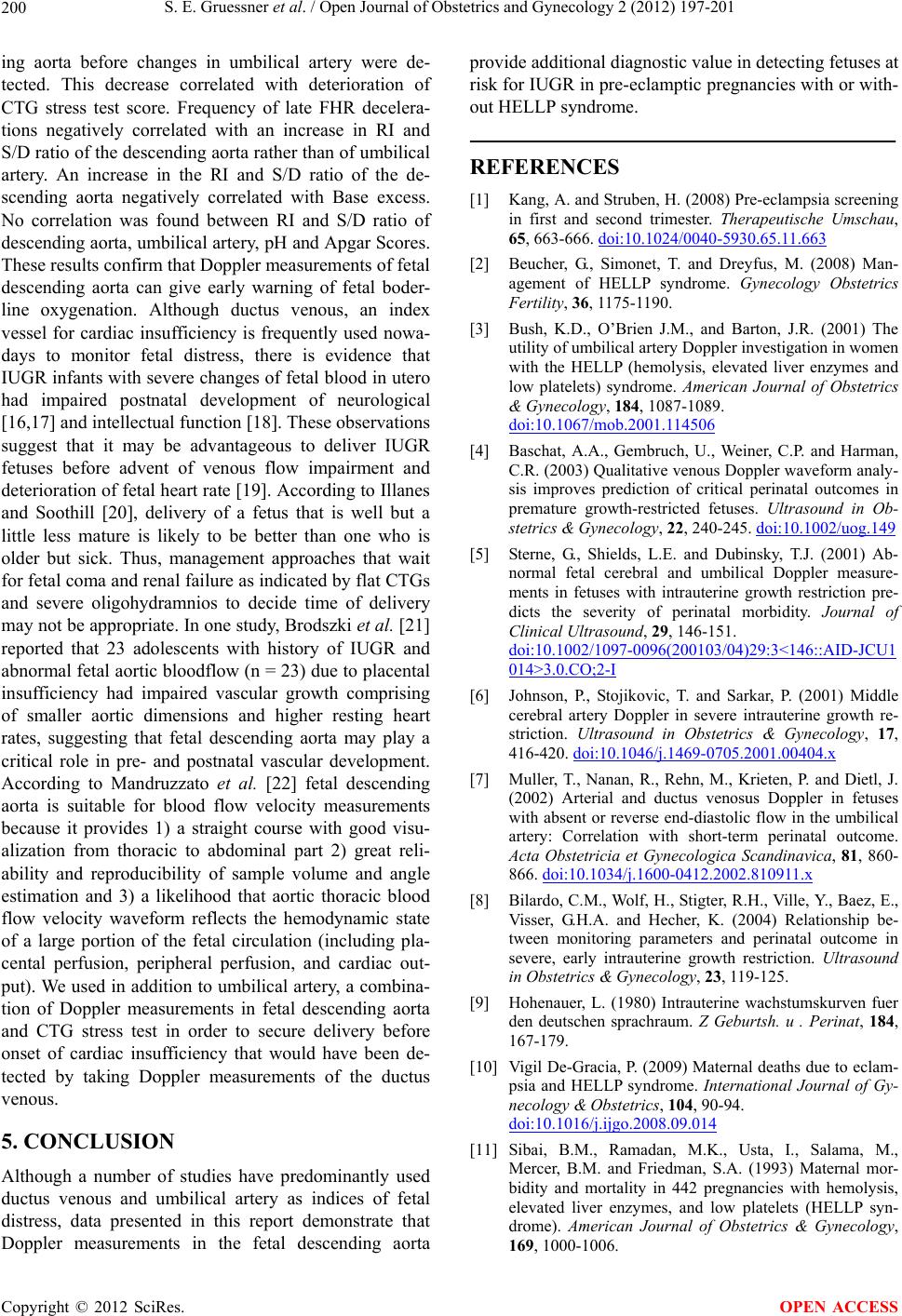
S. E. Gruessner et al. / Open Journal of Obstetrics and Gynecology 2 (2012) 197-201
200
ing aorta before changes in umbilical artery were de-
tected. This decrease correlated with deterioration of
CTG stress test score. Frequency of late FHR decelera-
tions negatively correlated with an increase in RI and
S/D ratio of the descending aorta rather than of umbilical
artery. An increase in the RI and S/D ratio of the de-
scending aorta negatively correlated with Base excess.
No correlation was found between RI and S/D ratio of
descending aorta, umbilical artery, pH and Apgar Scores.
These results confirm that Doppler measurements of fetal
descending aorta can give early warning of fetal boder-
line oxygenation. Although ductus venous, an index
vessel for cardiac insufficiency is frequently used nowa-
days to monitor fetal distress, there is evidence that
IUGR infants with severe changes of fetal blood in utero
had impaired postnatal development of neurological
[16,17] and intellectual function [18]. These observations
suggest that it may be advantageous to deliver IUGR
fetuses before advent of venous flow impairment and
deterioration of fetal heart rate [19]. According to Illanes
and Soothill [20], delivery of a fetus that is well but a
little less mature is likely to be better than one who is
older but sick. Thus, management approaches that wait
for fetal coma and renal failure as indicated by flat CTGs
and severe oligohydramnios to decide time of delivery
may not be appropriate. In one study, Brodszki et al. [21]
reported that 23 adolescents with history of IUGR and
abnormal fetal aortic bloodflow (n = 23) due to placental
insufficiency had impaired vascular growth comprising
of smaller aortic dimensions and higher resting heart
rates, suggesting that fetal descending aorta may play a
critical role in pre- and postnatal vascular development.
According to Mandruzzato et al. [22] fetal descending
aorta is suitable for blood flow velocity measurements
because it provides 1) a straight course with good visu-
alization from thoracic to abdominal part 2) great reli-
ability and reproducibility of sample volume and angle
estimation and 3) a likelihood that aortic thoracic blood
flow velocity waveform reflects the hemodynamic state
of a large portion of the fetal circulation (including pla-
cental perfusion, peripheral perfusion, and cardiac out-
put). We used in addition to umbilical artery, a combina-
tion of Doppler measurements in fetal descending aorta
and CTG stress test in order to secure delivery before
onset of cardiac insufficiency that would have been de-
tected by taking Doppler measurements of the ductus
venous.
5. CONCLUSION
Although a number of studies have predominantly used
ductus venous and umbilical artery as indices of fetal
distress, data presented in this report demonstrate that
Doppler measurements in the fetal descending aorta
provide additional diagnostic value in detecting fetuses at
risk for IUGR in pre-eclamptic pregnancies with or with-
out HELLP syndrome.
REFERENCES
[1] Kang, A. and Struben, H. (2008) Pre-eclampsia screening
in first and second trimester. Therapeutische Umschau,
65, 663-666. doi:10.1024/0040-5930.65.11.663
[2] Beucher, G., Simonet, T. and Dreyfus, M. (2008) Man-
agement of HELLP syndrome. Gynecology Obstetrics
Fertility, 36, 1175-1190.
[3] Bush, K.D., O’Brien J.M., and Barton, J.R. (2001) The
utility of umbilical artery Doppler investigation in women
with the HELLP (hemolysis, elevated liver enzymes and
low platelets) syndrome. American Journal of Obstetrics
& Gynecology, 184, 1087-1089.
doi:10.1067/mob.2001.114506
[4] Baschat, A.A., Gembruch, U., Weiner, C.P. and Harman,
C.R. (2003) Qualitative venous Doppler waveform analy-
sis improves prediction of critical perinatal outcomes in
premature growth-restricted fetuses. Ultrasound in Ob-
stetrics & Gynecology, 22, 240-245. doi:10.1002/uog.149
[5] Sterne, G., Shields, L.E. and Dubinsky, T.J. (2001) Ab-
normal fetal cerebral and umbilical Doppler measure-
ments in fetuses with intrauterine growth restriction pre-
dicts the severity of perinatal morbidity. Journal of
Clinical Ultrasound, 29, 146-151.
doi:10.1002/1097-0096(200103/04)29:3<146::AID-JCU1
014>3.0.CO;2-I
[6] Johnson, P., Stojikovic, T. and Sarkar, P. (2001) Middle
cerebral artery Doppler in severe intrauterine growth re-
striction. Ultrasound in Obstetrics & Gynecology, 17,
416-420. doi:10.1046/j.1469-0705.2001.00404.x
[7] Muller, T., Nanan, R., Rehn, M., Krieten, P. and Dietl, J.
(2002) Arterial and ductus venosus Doppler in fetuses
with absent or reverse end-diastolic flow in the umbilical
artery: Correlation with short-term perinatal outcome.
Acta Obstetricia et Gynecologica Scandinavica, 81, 860-
866. doi:10.1034/j.1600-0412.2002.810911.x
[8] Bilardo, C.M., Wolf, H., Stigter, R.H., Ville, Y., Baez, E.,
Visser, G.H.A. and Hecher, K. (2004) Relationship be-
tween monitoring parameters and perinatal outcome in
severe, early intrauterine growth restriction. Ultrasound
in Obstetrics & Gynecology, 23, 119-125.
[9] Hohenauer, L. (1980) Intrauterine wachstumskurven fuer
den deutschen sprachraum. Z Geburtsh. u . Perinat, 184,
167-179.
[10] Vigil De-Gracia, P. (2009) Maternal deaths due to eclam-
psia and HELLP syndrome. International Journal of Gy-
necology & Obstetrics, 104, 90-94.
doi:10.1016/j.ijgo.2008.09.014
[11] Sibai, B.M., Ramadan, M.K., Usta, I., Salama, M.,
Mercer, B.M. and Friedman, S.A. (1993) Maternal mor-
bidity and mortality in 442 pregnancies with hemolysis,
elevated liver enzymes, and low platelets (HELLP syn-
drome). American Journal of Obstetrics & Gynecology,
169, 1000-1006.
Copyright © 2012 SciRes. OPEN ACCESS